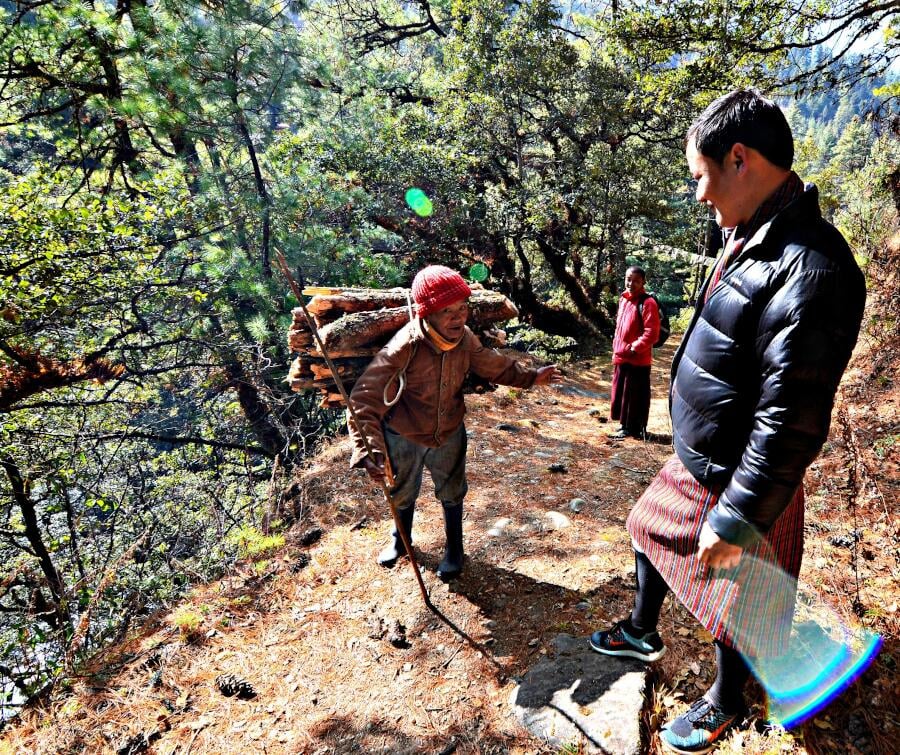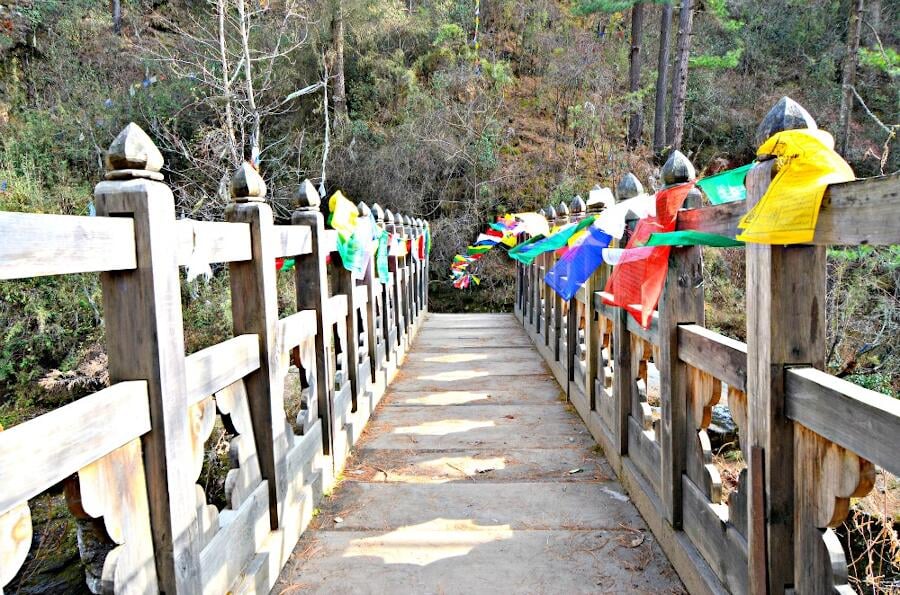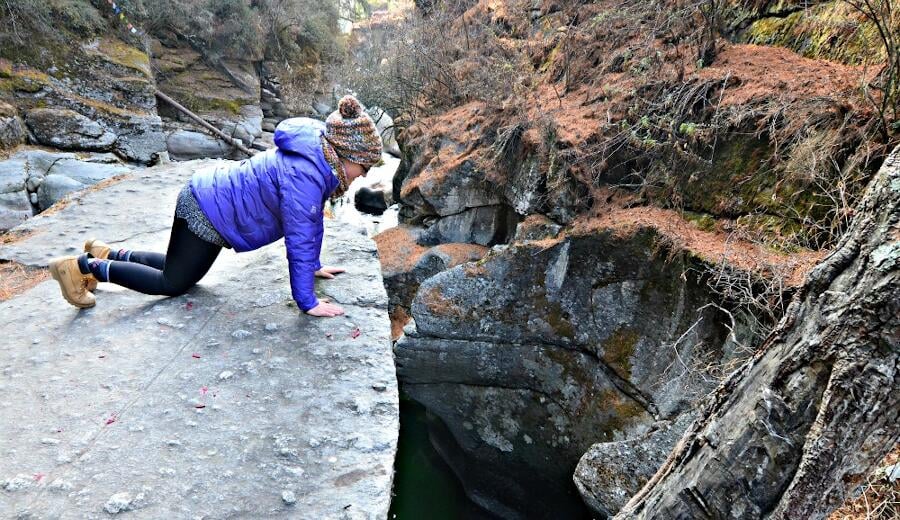Exploring Jakar, The Switzerland Of Bhutan
“And here is some locally made Swiss cheese, right here from the Jakar,” my waitress at the Mountain Lodge in Bumthang, Bhutan smiles.
Swiss cheese from Bhutan?
It may sound funny, but the dramatic landscapes of the four valleys hugged by high altitude trees jutting from high peaks — including Bhutan’s tallest mountain, Gangkhar Puensum, at 24,836 feet — that make up Jakar have earned it an equally dramatic nickname.
Jakar is located in Bumthang, a district also known for buckwheat and honey — a delicious combo I enjoy through sweet-topped pancakes at my hotel.
Moreover, the area is renowned for its outdoor adventure (it’s home to some beautiful hiking trails), yak and sheep wool handicrafts, and for being the birthplace of Buddhism in Bhutan (another nickname is the “Holy Heartland of Buddhism”), all of which I experience during my two-night stay in the district.
One quick tip before we continue:
Grab my free Ultimate Travel Planning Kit — which also includes a downloadable Google Map of my full Bhutan itinerary.
Add the map to your phone to have it ready to go for your trip!
There’s Nowhere Like Bhutan
Before we get into this Bhutan travel guide, I’ve got a video for you:
Watch it for an overview of what makes Bhutan unlike any other place in the world.
Hint:
This gorgeous birthplace of Buddhism in Bhutan is just one of the country’s one-of-a-kind facets.
Plus, you’ll see some of my favorite Bhutan trip photos.
If you’d like in-depth explanations of each point made in the video, check out my post on quirky Bhutan facts here.
Beautiful Buildings In Jakar, Bhutan
The first thing I notice, both at my 4-star hotel and when wandering the valley village, is the preference for wood construction over stone and mud, as I’d seen in Thimphu and Punakha.
My hotel, in particular, is the epitome of upscale rustic, the smell of local pine, the sight of chocolate and tan tones, and the sound of crackling fireplace dominating the common spaces, while my room has a slate shower large enough to fit 10 people at once and my windows offer beautiful views over the landscape.
A Scenic & Spiritual Hike Through The Switzerland Of Bhutan
I put on my hiking clothing and set out to immerse myself in this local pine on a hike from Kurji Lhakhang (Temple) to Thangbi Village, located within the Wangchuck Centennial Park, with my Bhutan Tourister guide, Kinley.
Parking the car in the temple parking lot, we head north on the road by foot, cows, farmhouses and fields of crops and wild marijuana meeting the edge of the mountain slopes.
My gaze starts at their base, moving up to the protruding pieces of green ground holding billowing prayer flags and hillside homes that, to an outsider, look exotic albeit precariously positioned.
Almost immediately the Chamkhar Chu begins rushing to our right, a light yet vibrant turquoise river splashing glacial waters over boulders and stretching south into India.
Even when we enter the forest, a woodland canopy of blue pine and oak shading us from the sun, I still glimpse its waters.
I can’t help but notice it smells like home, and despite being in one of the world’s most remote destinations I’m transported to the Catskills of New York.
We walk along a man-made rock and dirt road littered with pine cones until eventually, we reach a fork.
The upper path heads toward Tibet and the base camp for Gangkhar Puensum, though skiing and climbing are illegal as one might disturb the mountain spirits.
The lower path, which we take, leads us toward our destination of Thangbi Village.
Exploring Bhutan In An Un-Touristy Locale
Kinley explains this place isn’t frequented by tourists at all, and I feel even more excited to get to see it.
Sure, there are no grand palaces or elaborate attractions, but the small homes with their wooden frames painted beautifully with Buddhist-inspired lotus flowers and offering vessels, pitched roofs and floral shaped window frames look so natural sounded by farmland and mountains.
Locals chop wood, children play on the roadside and more colorful prayer flags billow in the breeze for good luck.
We eventually come to what Kinley tells me is a “money wall,” a large stone wall shrouded in prayer flags, with big painted rocks reading “May all sentient being lazy rest in peace” — a mantra from the God of Compassion — in the local Dzongkha language.
There are also small clay tsatsas shaped like palm-sized stupas for good luck as well as some left to liberate the soul of the dead by mixing the clay the human ashes.
We walk around clockwise to bring good luck into our lives, as Buddhists believe moving in this direction helps stir out negative energy.
Spiritual Encounters & Beautiful Scenery Of Bhutan
On the way back we encounter a monk who has just returned from a six-year silent retreat.
Not surprisingly, he’s extremely chatty (I know I would be too after that much silence), talking animatedly to my guide in Dzongkha.
I’m thankful, as he shows us a new way back which he calls “The Old Trail.”
I like this path; it feels more natural with a Mother Nature-made dirt path, and has some Buddha and stupa carvings in the rock showing the locals’ undying locally to Buddhism (Bhutan is over 80% Buddhist, with the rest being mainly Hindu).
After some downhill maneuvering, we cross a bridge with stunning views from above the river, then climb a steep but short path to emerge back onto a road.
Facing the road we turn left, eventually coming to the original fork at the beginning of the hike, and I realize I’ve just gotten to explore the upper section a bit.
Exploring Kurji Lhakhang In Jakar
We trek back to the Kurji Lhakhang parking lot, although instead of getting into the car we head inside the sacred structure.
There are thousands of temples in the country, but this one is extra special, as it’s where Buddhism began in Bhutan.
According to Kinley, in the 8th century, a demon known as Shelging Karpo took the soul of the king at the time, King Sindhu Raja.
Padmasambhava (the Second Buddha) came all the way from India to help resolve the situation, though upon hearing this the demon turned himself into a white lion and hid inside a cave in the temple, which you can still see today inside the alter of the lower section.
Padmasambhava was no fool though, and subdued the demon, turning him into a Buddhist practitioner that is now the deity of Jakar, protecting the land.
This is how Buddhism in Bhutan all began.
Within the three public spaces, and along with aerial views of the valley from the site I move aside to let a local woman do her prostrations and record them using prayer beads.
Before me sit beautiful Buddha statues, figures depicting the Eight Manifestations of Padmasambhava, colorful clay idols telling the story of Buddhism, and ornate alters with colorful ritual cakes, flickering butter lamps and solid gold offering bowls.
A Holistic Outdoors Experience
But spirituality isn’t just found within grand temples in Bhutan.
In this country, in fact, it’s possible to explore my love of culture and the outdoors combined.
About six miles from Jakar in the Tang Valley — Bumthang’s most remote valley — this is done at Mebar Tsho (Burning Lake).
From the car park, we walk down a steep rock stairway for less than 10 minutes before reaching a small altar and temple with three shiny Buddhas, as well as strings of prayer flags hung from a wooden bridge and hundreds of tsatsas sitting in the rock face.
The view from the bridge is stunning, one side showcasing a rushing glacial river and the other the calming lake interrupted only by smooth protruding stone.
The lake gets its name from Terton Pema Lingpa (the Third Buddha), also known as the “Treasure Discoverer,” according to Kinley.
It’s said that in the 15th century he discovered a small statue that had been hidden by Padmasambhava.
When retrieving it, he’d had a lit burning butter lamp in his palm. When he emerged from the water, it was still burning.
“It’s said if you look into the lake with a clear heart you can see a temple,” says Kinley, staring intently at the meditative waters.
If that were to happen anywhere, I’m not surprised it would be this genuinely soothing place — this valley — so full of natural beauty and human reverence; a spirituality that has dominated this valley, the Switzerland of Bhutan, since 746 AD.
Planning a trip to Bhutan?
Check out these essential Bhutan travel tips.
Bonus Bhutan Travel Resources:
What Everyone Should Know About Planning A Trip To Bhutan
How To Hike To Bhutan’s Breathtaking Tiger’s Nest
13 Things That Make Bhutan Unlike Any Place In The World
Is Bhutan Worth The $250 Per Night Fee?
6 Highs & 6 Lows From A Trip To Bhutan
Exploring Bhutan’s Phobjikha Valley, Land Of The Rare Black-Necked Crane
There’s A Place In Bhutan That Is Obsessed With Penises
10 Amazing & Immersive Experiences To Have In Thimphu, Bhutan
10 Reasons Why Bhutan Should Be Your Next Travel Destination

Have you visited Jakar, the mini Switzerland of Bhutan?
Essential Jakar Travel Info:
Stay: Mountain Lodge in Jakar. Great Wi-Fi, tasty food, extremely hospitable staff and the nicest rooms of my whole trip. The only issue may be that the property was under renovation when I went, which is how I was able to stay at this 4-star hotel (your nightly $200-$250 fee allows for 3-star hotels). Check with your guide.
Recommended Tour Operator: I went with Bhutan Tourister and had an unbelievable time. I highly recommend them. Please use this booking form for inquiries.
Booking Your Trip: By law, tourists visiting Bhutan must have a guide and must pay an all-inclusive rate of $200-$250 per night (low vs high season) + airfare + $40 Bhutan visa fee (unless you’re an Indian, Bangladeshis or Maldivian national) + $30-$40 nightly tariff for duo and solo travelers. This includes your private guide, 3-star lodging, three (huge!) meals per day and ground transfers.
Responsible Tourism: Making it more difficult to visit Bhutan limits the amount of tourists entering the country, helping to preserve the landscape and traditional culture. Moreover, 35% of what you pay goes to the government to put toward free education and healthcare, infrastructure and conservation.
Health: Healthcare is free for locals and visitors in Bhutan. I didn’t encounter any hotels with gyms, so if you’re looking to stay in shape I recommend Yoga Download (900+ yoga classes right on your laptop or phone), TheraBands (inexpensive resistance bands that take up virtually no luggage space) and a FitBit wristband (encourages you to be healthy and is stylish).
Paying For Your Trip: As a points-obsessed traveler, it stung not be able to pay for the trip with my credit card. To pay for your trip you’ll need to transfer the funds in US dollars to the tourism board’s bank account. The fee for me personally through Bank of America was $45 for the transfer, though they were kind enough to waive it for me as I’m a preferred client, so that was sweet. You can easily make the transfer online if you do online banking.
Language: Dzongkha & English
Local Currency: Ngultrum (Nu). As of February 2016, 1 Nu= $0.01.
Tipping: I tipped my guide the equivalent of $10/day, as I read $8-$10/day was the norm on numerous forums and travel agency sites.
Internet: Most of the hotels I stayed at had pretty decent Wi-Fi, though there was one that said they had Wi-Fi and it didn’t work. Homestays will likely not have Wi-Fi. If you want to stay connected I recommend getting a local SIM card from TashiCell, which cost about $10 for the SIM and 10 days of credit (depending how much you’ll use it, I had lots of credit left over but I didn’t use mine much), or a KnowRoaming Global SIM Sticker to affix to your regular SIM for local rates.
Food: If you like heat, you’ll love the chili-laden Bhutanese food, though many hotels cater to tourists with more general meat and veggie dishes. I was never hungry, as portions are huge and heavy, typically featuring a heaping bowl of red rice with pasta, potatoes, fish, cheese-topped chilies, cheese-topped mushrooms, turnip flowers and other meats and veggies. That being said the food won’t be what you write home about; it’ll be the well-preserved culture and heritage as well as the beautiful mountainous, green landscapes, 72% of which are covered in forest, unlike anywhere else.
Booze/Tobacco/Weed: Bhutan is a booze-friendly country (the small capital of Thimphu has 700 bars alone), though note the country is dry on Tuesdays, which is also the day many sites and shops are closed. Despite growing plentifully weed is illegal, and tobacco is illegal to sell. You can bring your own cigarettes purchased from another country, but be prepared to pay a 200% tax on them at customs.
Plugs: The outlets varied at the hotels. In some I was able to plug a standard USA-style plug into the wall, while at others I needed the European two-prong kind. Click here for a visual. It’s recommended to get a TravelMore International Travel Adapter with USB ports so you can charge multiple devices with one gadget.
Dress: While it won’t cause an uproar if you wear a tank top and shorts, it’s a respectful gesture to keep shoulders and knees covered when not in your hotel room. This is mandatory in the local temples (as well as no hats!) which you’ll be visiting a lot of. One travel essential to carry that’s great for this is a scarf shawl — which also works as an airplane blanket!
Essential Gear: Even if you visit in the warmer months it’s essential to bring warm clothes, as the mountains can get chilly all year round. Some items I recommend:
- Smartwool socks
- Stonewear Breathe Pants
- Moisture-wicking tops
- Columbia Women’s Snow Eclipse Mid Jacket
- Classic BUFF
- BUFF hat and neck warmer set
- ExOfficio Vona Gloves
- Ahnu Montara II Waterproof Hiking Shoes
- SteriPEN (The tap water is NOT drinkable in Bhutan, though your guide and hotel should supply it. I drink a lot so I also used my SteriPEN)
- XT driFILL Women’s Goose Down Waterproof Hooded Jacket

Hi, I’m Jessie on a journey!
I'm a conscious solo traveler on a mission to take you beyond the guidebook to inspire you to live your best life through travel. Come join me!

Want to live your best life through travel?
Subscribe for FREE access to my library of fun blogging worksheets and learn how to get paid to travel more!



















Will be headed there later this year, can’t wait! Thanks for the post and looking forward to seeing more from you about this magical kingdom.
@Jon: You will have an amazing time. Bhutan is truly unlike any other place in the world!
Thank you for the great memories, you brought back, of your Bhutan posts. Wife and I went 2 years ago and enjoyed every minute with our guide and the gracious people throughout the country
Wife climb all the way to tigers nest at age 77. I stayed at the cafeteria to cheer her on.
@Remy: Ah, that’s amazing! It definitely wasn’t an easy climb (but so worth it). I hope to get back to do it again someday!